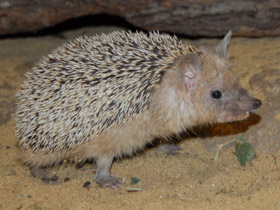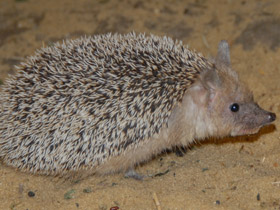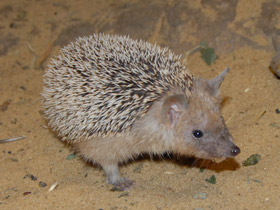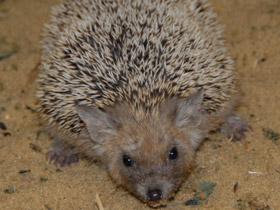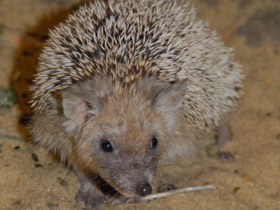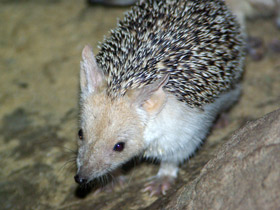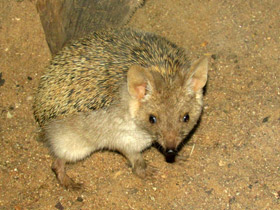The long-eared hedgehog (Hemiechinus auritus)
Description and characteristics of the long-eared hedgehog
The long-eared hedgehog (Hemiechinus auritus) is a species of erinaceomorphic mammal in the family Erinaceidae.
This charming beast differs from the common hedgehog and the white-bellied hedgehog by its remarkable 5 cm long ears. Hemiechinus auritus can go for a long time without eating or drinking.
In case of danger, they do not usually curl up into a ball, but lower their heads, hiss and try to prick their adversary. Hemiechinus auritus is very resistant to heat and many toxins (snake, bee and wasp venoms). For example, Hemiechinus auritus is 45 times more resistant to viper venom than the guinea pig.
Hemiechinus auritus is the smallest of the hedgehogs: its body length is 14-23 cm and its weight is about 500 grams. Its mantle of scales is more precise than that of the common hedgehog: its ribbed needles are rather short and evenly arranged.
They do not descend so far down the sides of the body that, when the hedgehog runs, not only its slippery legs are visible, but also partly the sides of the body and almost the entire head. The fur on the parts of the body not covered with needles is rather soft. Hemiechinus auritus gets its name from its large ears: when calm or alert, they protrude above the needle-like carapace. When the animal is frightened, it hides its ears, folding them in half and folding the top. The almost fully open head, large ears and eyes give Hemiechinus auritus an amusing and rather attractive appearance, which distinguishes it from the more often "frowning" common hedgehog.
Distribution and social behaviour
Hemiechinus auritus is widespread in arid climates from North Africa to Mongolia. In Russia, it is found in the pre-Caucasian semi-deserts between the Black and Caspian Seas and in southern western Siberia along the border with Kazakhstan.
Hemiechinus auritus, unlike the European Hemiechinus auritus, is a typical inhabitant of open semi-desert areas. These rodents are most numerous in areas with developed herbaceous vegetation in dry river valleys, ravines, near abandoned ditches and canals and among scattered shrubs. They avoid not only bare deserts with rapidly burning vegetation, but also steppe areas with dense herbaceous vegetation, which are absolutely impassable for this thorny creature. In steppe regions, however, Hemiechinus auritus can often be found in forest belts where thin stands of acacia, mulberry and oak are combined with stunted grass.
Hemiechinus auritus lives mostly solitary; it hides for a day in the burrows it digs and rarely uses other burrows. Its dwelling is a simple underground passage, about a metre long, ending with a small hole at a depth of 30-40 cm. Occasionally two or three beetles may be found in the same burrow; however, each makes its own nesting chamber, and the only passage is the common one. These collective rookeries are formed closer to the cold, when the hedgehogs go into hibernation. Hemiechinus auritus hibernates for 5-6 months, from October to April.
Feeding
When out in search of prey at night, the beast will explore all the recesses of its territory without following a particular route. It is not cautious, it is noisy, and its sniffing and snorting can be heard many metres away. When searching for food, its sense of smell is paramount. When several hedgehogs gather near a large prey item, they share it quite peacefully. Only when they have taken a mouthful do Hemiechinus auritus fight furiously: they try to outdo each other, and piercing wails echo in the surroundings. The most common prey of the long-eared hedgehog are locusts, large beetles and ants; occasionally it may catch a lizard or a gerbil. Hemiechinus auritus will not ignore a bird's nest hidden under a bush, nor will it pass by a fallen tree. In late summer, it greedily gathers the fruits on the ground; if it is hungry, it can satisfy itself only with leaves of succulent plants. In captivity, Hemiechinus auritus will eat almost anything from milk to fresh tomatoes. Living far from water reservoirs, it may go for a long time without drinking, but if possible, it will drink frequently, like its forest counterpart.
Reproduction
The breeding period of Hemiechinus auritus is very long, depending on when the females emerge from hibernation, their physiological state and food supply. Oestrus is most active in April-May; gestation lasts about a month; a litter contains 3-6 young, weighing only 5-10 g at birth. The young are born without hair or needles, but within hours of birth they are covered with short, soft white or black needles.
All care of their young falls to the female hedgehog; she spends most of her time with her young, feeds them with milk 3-4 times a day and leaves the nest for a while to get something to eat. After a week, the hedgehogs snort when touched by a foreign object, try to prick themselves with needles and curl up. At two weeks of age, the hedgehog's needle cover is the same as that of an adult. One month later, at the end of milking, they weigh ten times as much as at birth. At two months of age, the hedgehogs leave the nest, but not the mother, and usually stay with her until the following spring. Hemiechinus auritus has a lifespan of five to six years.

















